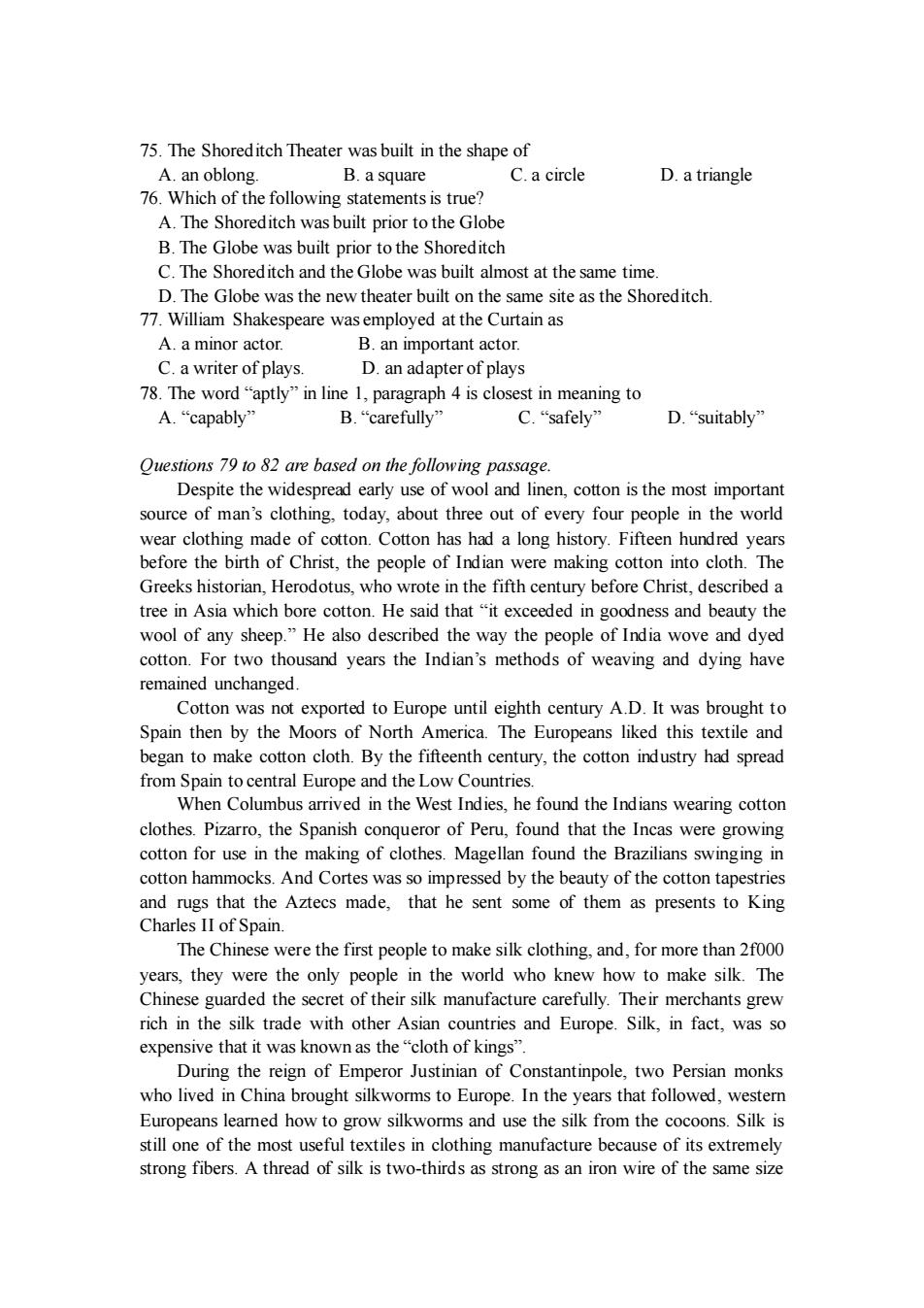正在加载图片...

75.The Shoreditch Theater was built in the shape of A.an oblong. B.a square C.a circle D.a triangle 76.Which of the following statements is true? A.The Shoreditch was built prior to the Globe was built almost at the same time D.The Globe was the new theater built on the same site as the Shoreditch. 77.William Shakespeare was employed at the Curtain as A.a minor actor B.an important actor. C.a writer of plays D.an adapter of plays 78.The word "aptly in line 1.paragr C.l to h 4 is closest in me A.“capably B."carefully D.“suitably Questions 79 to 82 are based on the following passage. Despite the widespread early use of wool and linen,cotton is the most important oof man's clthing.today,about three ouof evry four peope in the world ing made of Cotton has istory.Fifteen hundred inh of Chit.the r t yea Greeks historian.Herodotus.who wrote in the fifth century before Christ.described a tree in Asia which bore cotton.He said that"it exceeded in goodness and beauty the wool of any sheep."He also described the way the people of India wove and dyed cotton.For tw housand years the Ind an's s meth of weaving and dying have remained unchanged Cotton was not exported to Europe until eighth century A.D.It was brought to Spain then by the Moors of North America.The Europeans liked this textile and began to make cotton cloth.By the fifteenth century.the cotton industry had spread from Spain tocentral Eu hen Col bus amive in the West Indies.he found the Indians wearing cottor clothes.Pizarro,the Spanish conqueror of Peru,found that the Incas were growing cotton for use in the making of clothes.Magellan found the Brazilians swinging in cotton hammocks.And Cortes was so impressed by the beauty of the cotton tapestries and rugs that the Aztecs made,that he sent some of them as presents to King Charles I ofS pa The Chinese were the first people to make silk clothing.and.for more than 2f00 years,they were the only people in the world who knew how to make silk.The Chinese guarded the secret of their silk manufacture carefully.Their merchants grew rich in the silk trade with other Asian countries and Europe.Silk,in fact,was so expe nsive that it was kr n as the"cloth of kin During the reign of Emperor Justinian of Constantinpole,tw Persian monks who lived in China brought silkworms to Europe.In the years that followed,westem Europeans learned how to grow silkworms and use the silk from the cocoons.Silk is still one of the most useful textiles in clothing manufacture because of its extremely strong fibers.A thread of silk is two-thirds as strong as an iron wire of the same size75. The Shoreditch Theater was built in the shape of A. an oblong. B. a square C. a circle D. a triangle 76. Which of the following statements is true? A. The Shoreditch was built prior to the Globe B. The Globe was built prior to the Shoreditch C. The Shoreditch and the Globe was built almost at the same time. D. The Globe was the new theater built on the same site as the Shoreditch. 77. William Shakespeare was employed at the Curtain as A. a minor actor. B. an important actor. C. a writer of plays. D. an adapter of plays 78. The word “aptly” in line 1, paragraph 4 is closest in meaning to A. “capably” B. “carefully” C. “safely” D. “suitably” Questions 79 to 82 are based on the following passage. Despite the widespread early use of wool and linen, cotton is the most important source of man’s clothing, today, about three out of every four people in the world wear clothing made of cotton. Cotton has had a long history. Fifteen hundred years before the birth of Christ, the people of Indian were making cotton into cloth. The Greeks historian, Herodotus, who wrote in the fifth century before Christ, described a tree in Asia which bore cotton. He said that “it exceeded in goodness and beauty the wool of any sheep.” He also described the way the people of India wove and dyed cotton. For two thousand years the Indian’s methods of weaving and dying have remained unchanged. Cotton was not exported to Europe until eighth century A.D. It was brought to Spain then by the Moors of North America. The Europeans liked this textile and began to make cotton cloth. By the fifteenth century, the cotton industry had spread from Spain to central Europe and the Low Countries. When Columbus arrived in the West Indies, he found the Indians wearing cotton clothes. Pizarro, the Spanish conqueror of Peru, found that the Incas were growing cotton for use in the making of clothes. Magellan found the Brazilians swinging in cotton hammocks. And Cortes was so impressed by the beauty of the cotton tapestries and rugs that the Aztecs made, that he sent some of them as presents to King Charles II of Spain. The Chinese were the first people to make silk clothing, and, for more than 2f000 years, they were the only people in the world who knew how to make silk. The Chinese guarded the secret of their silk manufacture carefully. Their merchants grew rich in the silk trade with other Asian countries and Europe. Silk, in fact, was so expensive that it was known as the “cloth of kings”. During the reign of Emperor Justinian of Constantinpole, two Persian monks who lived in China brought silkworms to Europe. In the years that followed, western Europeans learned how to grow silkworms and use the silk from the cocoons. Silk is still one of the most useful textiles in clothing manufacture because of its extremely strong fibers. A thread of silk is two-thirds as strong as an iron wire of the same size